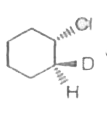In the following questions, a statement of assertion (A) is following by a statement of reason (R )
A : when chloroform is obtained from bleaching powder and ethanol then chlorine acts as oxidising agent only.
R : It oxidises ethanol into acetic acid.
If both Assertion & Reason are the reason is the correct explanation of the assertion, then mark (1).
If both Assertion & Reason are true but the reason is not the correct explanation of the assertion, then mark(2).
If Assertion is true statement but Reason is false , then mark (3)
If both Assertion and Reason are false statements, then mark (4)
The correct Answer is:D
To analyze the assertion (A) and reason (R) provided in the question, let's break down the information step by step.
Step 1: Understanding the Assertion
Assertion (A): When chloroform is obtained from bleaching powder and ethanol, then chlorine acts as an oxidizing agent only.
- Explanation: In the reaction involving bleaching powder (calcium oxychloride, Ca(OCl)2) and ethanol (C2H5OH), chlorine (Cl2) is generated. This chlorine acts as an oxidizing agent in the reaction.
Step 2: Reaction of Chlorine with Ethanol
- When chlorine reacts with ethanol, it oxidizes ethanol to acetaldehyde (CH3CHO) rather than acetic acid (CH3COOH).
- The reaction can be represented as:
C2H5OH+Cl2→CH3CHO+2HCl
- Here, ethanol is oxidized to acetaldehyde, and hydrochloric acid (HCl) is formed.
Step 3: Formation of Chloroform
- The acetaldehyde formed can further undergo a haloform reaction with bleaching powder to produce chloroform (CHCl3).
- The reaction can be represented as:
CH3CHO+Ca(OCl)2→CHCl3+Ca(OH)2+other products
- This shows that chloroform is indeed formed from the reaction of acetaldehyde with bleaching powder.
Step 4: Evaluating the Reason
Reason (R): It oxidizes ethanol into acetic acid.
- Explanation: This statement is incorrect because chlorine oxidizes ethanol to acetaldehyde, not acetic acid. Therefore, the reason provided does not support the assertion.
Conclusion
- The assertion (A) is correct because chlorine acts as an oxidizing agent in the formation of chloroform from ethanol.
- The reason (R) is incorrect because it states that ethanol is oxidized to acetic acid, while it is actually oxidized to acetaldehyde.
Final Answer
- The correct option is: Assertion is true, Reason is false.
---
Assertion (A): When chloroform is obtained from bleaching powder and ethanol, then chlorine acts as an oxidizing agent only.
- When chlorine reacts with ethanol, it oxidizes ethanol to acetaldehyde (CH3CHO) rather than acetic acid (CH3COOH).
- The reaction can be represented as:
C2H5OH+Cl2→CH3CHO+2HCl
- Here, ethanol is oxidized to acetaldehyde, and hydrochloric acid (HCl) is formed.
- The acetaldehyde formed can further undergo a haloform reaction with bleaching powder to produce chloroform (CHCl3).
- The reaction can be represented as:
CH3CHO+Ca(OCl)2→CHCl3+Ca(OH)2+other products
- This shows that chloroform is indeed formed from the reaction of acetaldehyde with bleaching powder.
Reason (R): It oxidizes ethanol into acetic acid.
- The assertion (A) is correct because chlorine acts as an oxidizing agent in the formation of chloroform from ethanol.
- The reason (R) is incorrect because it states that ethanol is oxidized to acetic acid, while it is actually oxidized to acetaldehyde.
- The correct option is: Assertion is true, Reason is false.
Topper's Solved these Questions
- HALOALKANES AND HALOARENES BOOK - AAKASH INSTITUTE ENGLISHCHAPTER - HALOALKANES AND HALOARENES EXERCISE - ASSIGNMENT SECTION - C
39 Videos
- GENERAL PRINCIPLES AND PROCESSES OF ISOLATION OF ELEMENTSBOOK - AAKASH INSTITUTE ENGLISHCHAPTER - GENERAL PRINCIPLES AND PROCESSES OF ISOLATION OF ELEMENTSEXERCISE - Try Yourself
33 Videos
- HYDROCARBONSBOOK - AAKASH INSTITUTE ENGLISHCHAPTER - HYDROCARBONSEXERCISE - Assignment(Section - C) (Previous Years Questions)
60 Videos
Similar Questions
In the following questions, a statement of assertion (A) is followed by a statement of reason (R )
A : O2 is paramagnetic .
R : N2 is paramagnetic .
View SolutionIn the following questions, a statement of assertion (A) is followed by a statement of reason (R )
A : Both methane and tetrachloromethane are nonpolar.
R : C-Cl bond is polar bond.
View SolutionIn the following questions, a statement of assertion (A) is followed by a statement of reason (R )
A : PCl5 exist but NCl5 does not
R : Nitrogen is highly inert.
View SolutionIn the following questions, a statement of assertion (A) is followed by a statement of reason (R )
A : H-F forms stronger hydrogen bond than H2O.
R : F is more electronegative than oxygen.
View SolutionIn the following questions a statement of assertion (A) is followed by a statement of reason ( R)
A : Cu, Ag, Au are known as coinage metal.
R: Coinage metals are d-block metals .
View SolutionIn the following questions, a statement of assertion (A) is followed by a statement of reason (R )
A : LiCl is more covalent than BeCl2
R : Li⋅ ion is smaller than Be2+ .
View SolutionIn the following questions, a statement of assertion (A) is following by a statement of reason (R )
A: on reaction with alcoholic KOH gives
on reaction with alcoholic KOH gives 
R: Bond energy of C-D bond is less than of C-H bond.
View SolutionIn the following question a statement of assertion (A) is followed by a statement of reason (R )
A: Absolute value of potential is not defined
R : Two equipotential lines cannot intersect each other.
View SolutionIn the following questions a statement of assertion (A) is followed by a statement of reason ( R)
A : Lanthanum ( Z: 57) is lanthanoid .
R : Valence electrons are present in 4 f orbital.
View SolutionIn the following questions a statement of assertion (A) is followed by a statement of reason ( R)
A: Be and AI show diagonal relationship .
R: Be and AI are diagonal to each other in the periodic table .
View Solution
